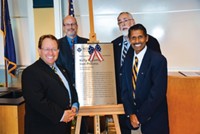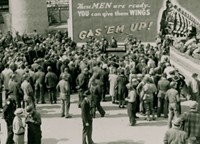Advertisement
Grab your lab coat. Let's get started
Welcome!
Welcome!
Create an account below to get 6 C&EN articles per month, receive newsletters and more - all free.
It seems this is your first time logging in online. Please enter the following information to continue.
As an ACS member you automatically get access to this site. All we need is few more details to create your reading experience.
Not you? Sign in with a different account.
Not you? Sign in with a different account.
ERROR 1
ERROR 1
ERROR 2
ERROR 2
ERROR 2
ERROR 2
ERROR 2
Password and Confirm password must match.
If you have an ACS member number, please enter it here so we can link this account to your membership. (optional)
ERROR 2
ACS values your privacy. By submitting your information, you are gaining access to C&EN and subscribing to our weekly newsletter. We use the information you provide to make your reading experience better, and we will never sell your data to third party members.
Environment
ACS Landmarks Laud Pennsylvania Oil Industry
Two landmarks are designated to celebrate 150 years of oil refining in the state
by Linda R. Raber
October 12, 2009
| A version of this story appeared in
Volume 87, Issue 41

In the 1850s, kerosene-burning lamps were beginning to replace candles for lighting U.S. homes. Demand for oil, which is distilled to make kerosene, led Col. Edwin Drake to Titusville, Pa., where, in 1859, he drilled the first successful commercial oil well and started the ball rolling for the development of the state’s petroleum industry. As part of Pennsylvania’s yearlong celebration of 150 years of petroleum progress, the American Chemical Society designated petroleum distillation and oil drilling as National Historic Chemical Landmarks.
On Aug. 26, in Pittsburgh, the construction of the first oil-refining still by Samuel Kier was lauded at the John Heinz History Center, and the next day, 100 miles north, ACS recognized Drake’s oil well at the Drake Well Museum in Titusville. ACS President Thomas H. Lane was on hand at both events to present plaques and tell ceremony attendees about the landmarks program and the significance of the new honorees.
Oil oozes to the surface in many parts of western Pennsylvania. Before it was recognized as a fuel source, the smelly goo was a nuisance contaminant of salt wells. Kier, whose family owned salt wells near Pittsburgh, made the best of a bad situation. Rather than dumping the oil into the Allegheny River, he bottled and marketed the stuff as Kier’s Petroleum, or Rock Oil. He claimed it cured burns, ulcers, cholera, asthma, indigestion, and rheumatism. It sold well, but Kier still couldn’t make enough money selling the unctuous cure-all.
Ever industrious, Kier began looking for other uses for his oil. He sent a sample to James Curtis Booth, who later became a president of ACS. Booth suggested distilling the oil for use in lighting. Kier built a cast-iron, one-barrel still and began selling the distillate kerosene, which he called Carbon Oil because at the time kerosene was a trade name for the same product refined from coal. Demand rose, but supplies were limited because of the difficulty of getting oil out of the ground.

At the Pittsburgh event, Lane unveiled a plaque that tells the story:
“Near this site in the 1850s Samuel Kier constructed a cast-iron distillation unit for refining crude oil. Kier’s one-barrel still produced kerosene, a clean burning lamp fuel. Later, Kier built a five-barrel still and invented a lamp that minimized smoke and odor. Kier’s refining process touched off the search for more dependable sources of crude oil, which led to the drilling of the nation’s first oil well in Titusville, Pennsylvania. These two technologies—refining and drilling—made western Pennsylvania the undisputed leader of the early oil industry.”
The search for oil sparked the imagination of Col. Drake. By no means a military man, Drake called himself “Colonel” because he believed it lent him a certain gravitas when courting potential sponsors for his newly formed Pennsylvania Rock Oil Co. Drake believed he could find oil in Titusville, and with the backing of his sponsors, he set up a base there and started drilling. On Aug. 27, 1859, with the drill at a depth of 69 feet, he hit oil, and an industry was born.
By the end of the year, wells sprouted throughout the region, producing 4,500 barrels. In 1860, wells in northwestern Pennsylvania had produced several hundred thousand barrels of oil, and by 1862, production had reached 3 million barrels. Drake may have drilled the first well, but he didn’t profit from his work. He didn’t own the land he was drilling, and in 1860, Seneca Oil Co. let him go—for $1,000, the price to use his name on barrels. He died poor in 1880.
In 1870, John D. Rockefeller organized Standard Oil, bringing order to the fledgling industry. But within 10 years, the coming of Thomas Edison’s light bulb and electrification replaced kerosene, threatening the dominance of oil. The petroleum industry was saved by the coming automobile industry and the need for gasoline, but its center had moved to Texas.
ACS established the chemical landmarks program in 1992 to recognize important historic events in chemistry and to increase awareness of the contributions of chemistry to society. Other landmarks named through this prestigious program include the invention of Bakelite, the discovery of penicillin, the development of Tide laundry detergent, and the work of historical figures including Joseph Priestley, Antoine Lavoisier, and George Washington Carver, among others. For more on the landmark program, visit www.acs.org/landmarks.





Join the conversation
Contact the reporter
Submit a Letter to the Editor for publication
Engage with us on Twitter